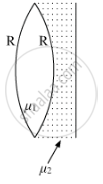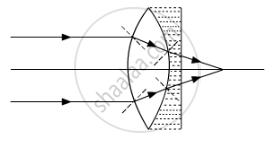Advertisements
Advertisements
Question
A biconvex lens with its two faces of equal radius of curvature R is made of a transparent medium of refractive index μ1. It is kept in contact with a medium of refractive index μ2 as shown in the figure.

(a) Find the equivalent focal length of the combination.
(b) Obtain the condition when this combination acts as a diverging lens.
(c) Draw the ray diagram for the case μ1 > (μ2 + 1) / 2, when the object is kept far away from the lens. Point out the nature of the image formed by the system.
Solution
From the lens maker formula, we have
`1/f=(μ−1)(1/R_1−1/R_2)`
where f=Focal length the lens
μ=Refractive index of material
R1=Radius of curvature of first face
R2=Radius of curvature of second face
Let f1 anf f2 be the focal lengths of the two mediums. Then,
`1/f_1=(μ_1−1)[1/R−(−1/R)]`
`⇒1/f=(μ_1−1)(2/R)1/f_2`
`=(μ_2−1)[(−1/R)−1/∞]`
`⇒1/f_2=(μ_2−1)(−1/R)`
(a) If feq is the equivalent focal length of the combination, then
`1/f_eq=1/f_1+1/f_2`
`⇒1/f_eq=(2(μ_1−1))/R−(μ_2−1)/R`
`⇒1/f_eq=(2μ_1−μ_2−1)/R`
`⇒f_eq=R/(2μ_1−μ_2−1)`
(b) For the combination to behave as a diverging lens, feq < 0
`⇒R/(2μ_1−μ_2−1)<0`
`⇒2μ_1−μ_2−1<0`
`⇒μ_1<(μ_2+1)/2`
which is the required condition
(c) For μ1>(μ2+1)/2, the combination will behave as the converging lens. So, an object placed far away from the lens will form image at the focus of the lens.

The image so formed will be real and diminished in nature.
APPEARS IN
RELATED QUESTIONS
Define the magnifying power?
The size of an object as perceived by an eye depends primarily on
To increase the angular magnification of a simple microscope, one should increase ______.
A child has near point at 10 cm. What is the maximum angular magnification the child can have with a convex lens of focal length 10 cm?
The angular magnification of a system is less than one. Does it mean that the image formed is inverted?
A magnifying glass is a converging lens placed close to the eye. A farsighted person uses spectacles having converging lenses. Compare the functions of a converging lens used as a magnifying glass and as spectacles.
The magnifying power of a simple microscope is given by `1+D/f` , where D is the least distance for clear vision. For farsighted persons, D is greater than the usual. Does it mean that the magnifying power of a simple microscope is greater for a farsighted person as compared to a normal person? Does it mean that a farsighted person can see an insect more clearly under a microscope than a normal person?
An optical instrument used for angular magnification has a 25 D objective and 20 D eyepiece. The tube length is 25 cm when the eye is least strained. (a) Whether it is a microscope or a telescope? (b) What is the angular magnification produced?
How does focal length of a convex lens change with increase in wavelength of incident light?
Magnification for spherical mirrors m is given by ______.
